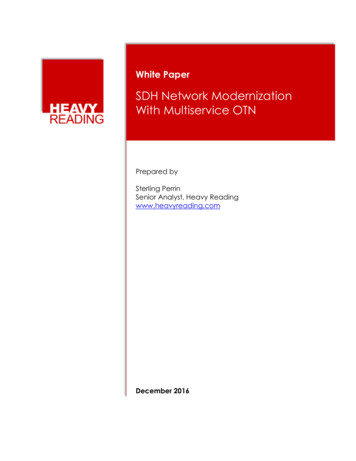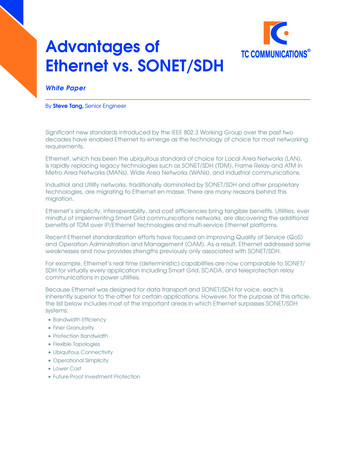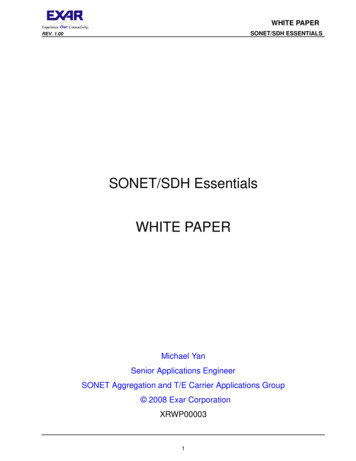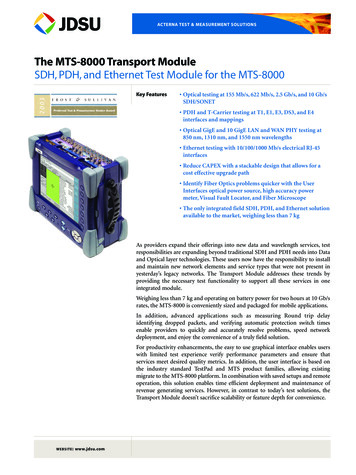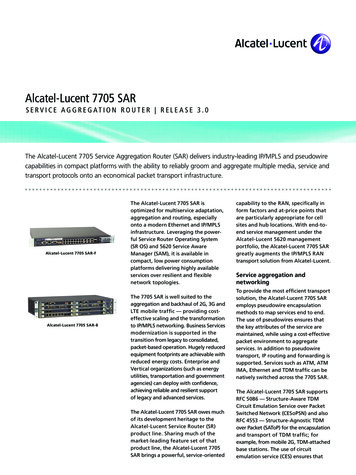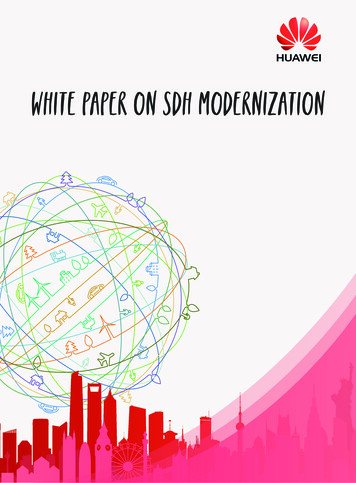
Transcription
White Paper on SDH Modernization3001
Copyright Huawei Technologies Co., Ltd. 2016. All rights reserved.No part of this document may be reproduced or transmitted in any form or by any means without priorwritten consent of Huawei Technologies Co., Ltd.Trademarks and Permissionsand other Huawei trademarks are trademarks of Huawei Technologies Co., Ltd.All other trademarks and trade names mentioned in this document are the property of their respectiveholders.NoticeThe purchased products, services and features are stipulated by the contract made between Huawei andthe customer. All or part of the products, services and features described in this document may not bewithin the purchase scope or the usage scope. Unless otherwise specified in the contract, all statements,information, and recommendations in this document are provided "AS IS" without warranties, guarantees orrepresentations of any kind, either express or implied.The information in this document is subject to change without notice. Every effort has been made in thepreparation of this document to ensure accuracy of the contents, but all statements, information, andrecommendations in this document do not constitute a warranty of any kind, express or implied.Huawei Technologies Co., Ltd.Address:Huawei Industrial BaseBantian, LonggangShenzhen 518129People's Republic of awei.comIssue 01 (2016-07-30)Huawei Proprietary and ConfidentialCopyright Huawei Technologies Co., Ltd.i
White Paper on SDH ModernizationContentsContents1 Introduction. 12 Driving Forces of SDH Modernization . 22.1 Service Evolution . 22.2 Market Evolution . 32.3 Legacy SDH Network Reconstruction . 52.4 Consensus Reached by Global Telecom Carriers . 63 SDH Modernization Target Is MS-OTN . 83.1 Full Inheritance of SDH Advantages Ensures Smooth SDH Replacement . 83.2 MS-OTN Inherits and Develops SDH . 93.3 MS-OTN Is Future-Oriented and Provides Better Bearer Experience . 104 Key Technologies of SDH Modernization . 134.1 Pain Points of SDH Network Reconstruction . 134.2 GNEEC Guarantees Network Evolution Solutions . 144.3 Automatic Tools for SDH Evolution and Reconstruction . 154.3.1 Data Parsing and Restoration Tool . 154.3.2 Target Network Design Tool . 164.3.3 TCO Analysis Tool . 174.4 SDH Evolution and Reconstruction Solutions . 184.4.1 Single-Site SDH Reconstruction Solution . 184.4.2 Ring Insertion SDH Reconstruction Solution . 184.4.3 E2E SDH Reconstruction Solution . 194.4.4 Values of SDH Evolution and Reconstruction Solutions . 195 SDH Modernization Values. 21Issue 01 (2016-07-30)Huawei Proprietary and ConfidentialCopyright Huawei Technologies Co., Ltd.ii
White Paper on SDH Modernization1 Introduction1IntroductionThe telecommunications industry continues to evolve, and telecommunications services andnetwork architecture today bear little resemblance to their predecessors from 10 years ago.Recently, services such as data center (DC) interconnection and 4K video have emerged, andtime division multiplexing (TDM) private line services pose new challenges on transportnetwork security, latency, and bandwidth. In this ever-changing environment, which bearertechnology is best suited for future transport networks? This white paper analyzessynchronous digital hierarchy (SDH), which has been deployed on a large portion oftelecommunications networks around the world for some time. This paper will also discussthe significance, targets, and key technologies of SDH modernization.Issue 01 (2016-07-30)Huawei Proprietary and ConfidentialCopyright Huawei Technologies Co., Ltd.1
White Paper on SDH Modernization22 Driving Forces of SDH ModernizationDriving Forces of SDH Modernization2.1 Service EvolutionSDH networks carry broadband, mobile, and private line services. private line service portsevolve from E1/E3 to fast Ethernet (FE), Gigabit Ethernet (GE), or even 10GE, but still useexclusive bandwidths, which are highly reliable. Moreover, high-value private line servicespose higher requirements on transport networks: low latency and high security.In terms of service attributes, broadband and mobile access services are basic services, andtelecom carriers choose the cost-effective scheme based on user distribution and networkresources. However, private line services are designed based on specific customerrequirements: Government or enterprise private lines: connect government or enterprise headquartersand branches. In the government or enterprise private lines, service security and networkreliability are top priorities. DC leased lines: connect DCs of Internet Content Provider (ICP). ICP customers needhigh-bandwidth private line networks, fast service provisioning, dynamic bandwidthadjustment, and private line network openness and customization. Private lines for Internet access: apply to Internet access in small and medium-sizedenterprises. Customers in these enterprises are sensitive to prices and require one-stopservice experience.Figure 2-1 Private line service market segmentsIssue 01 (2016-07-30)Huawei Proprietary and ConfidentialCopyright Huawei Technologies Co., Ltd.2
White Paper on SDH Modernization2 Driving Forces of SDH ModernizationGovernment and enterprise private line services and DC leased line services will be profitableservices in the coming years. High-value private line services have the following requirements:high security, zero service interruption, high reliability, low latency, short time to market(TTM), and dynamic adjustment.Security is the top concern of VIP customers for private line services. In the past, informationleak events have occurred when optical networks were intercepted using fiber bending. Forexample, telecommunications backbone networks in a European country were interceptednear an airport; hedge fund data in America was intercepted before its quarter data wasreleased; and 1.2 million customer information records were stolen from a financial company.Fiber bending interception is easily and cheaply implemented using a fiber fixture, photodiodedetector, optical-to-electrical converter, and laptop.In the standard definition (SD) and high definition (HD) video era, the bandwidth required bydigital TV programs is small, and can be satisfied with basic bandwidth and transmissionthroughput of home broadband. As 4K video services boom, the required bandwidth increasessignificantly. However, 4K video services also have stringent requirements for low latencyand packet loss rate. Therefore, to provide 4K video services, telecom carriers must improvethe entire network to ensure user experience.Video services feature ultra-large bandwidth, low oversubscription ratio, and high real-timeperformance. To bring the best video service experience and consider per-bit costs, telecomcarriers use the over 10G large pipe technology to optimize traffic paths and build a simplifiedbearer network, which is the best choice for 4K video services.DC interconnection and 4K video services require large pipes at a rate over 10G or even 100G,and the bandwidth can be customized and dynamically adjusted. Requirements of government,enterprise, and finance private line services on security and latency remain as least as strong.However, SDH cannot support a bandwidth exceeding 10G. To avoid this bottleneck, a newtransport technology is required in place of SDH.2.2 Market EvolutionBased on telecommunications market requirements, low-speed private line services will likelypersist for a long time, and high-speed private line services will grow rapidly. The followingfigure shows the change trend of low-speed private line services provided by telecom carriersin recent five to six years. It can be seen from the figure that TDM private line services suchas E1 and STM-1 persist for a long time, while FE and GE services keep growing.Issue 01 (2016-07-30)Huawei Proprietary and ConfidentialCopyright Huawei Technologies Co., Ltd.3
White Paper on SDH Modernization2 Driving Forces of SDH ModernizationFigure 2-2 Bandwidth change trend in the private line marketCustomers of TDM private line services are from security and finance enterprises, which havestringent requirements on security, reliability, and latency. Therefore, physical pipes arerequired for data transmission. High-speed private line services attract a small number ofgovernment and enterprise customers. The services emerge based on the DC interconnectionrequirements of ICP customers, which require short service provisioning time and on-demandbandwidth. Transport technologies and bearer networks that meet DC service requirementsare important for telecom carriers to attract DC customers.To remain competitive, telecom carriers must be able to provision services quickly. Thenetwork bandwidth can be dynamically adjusted by interval based on DC interconnectioncustomers' requirements. This helps improve channel utilization and achieve higher return oninvestment (ROI).Figure 2-3 Distribution of telecom carriers' private line service revenueAccording to market data of telecom carriers, TDM private line services make up a largeproportion of revenue, multiple times the revenue from private line services using IP andIssue 01 (2016-07-30)Huawei Proprietary and ConfidentialCopyright Huawei Technologies Co., Ltd.4
White Paper on SDH Modernization2 Driving Forces of SDH Modernizationother technologies. TDM private line services will likely still be profitable for telecomcarriers for the next decade or longer.According to market requirement changes, low-speed high-value TDM private line serviceswill persist for a long time, government and enterprise private line services pose higherrequirements on security and latency, and large-bandwidth DC leased line servicescontinuously grow. As private line services and private line market continuously change,telecom carriers urgently need a transport technology due to SDN network restrictions onbandwidth and capability for supporting packet services. The transport technology shouldinherit SDH features and support large bandwidth and strong capability for supporting packetservices. Currently, MS-OTN meets the requirements of telecom carriers.2.3 Legacy SDH Network ReconstructionBased on the telecommunications device lifecycle, SDH networks gradually enter end ofservice (EOS), telecom carriers reduce investments on SDH networks, the operating expense(OPEX) increase, and spare parts and services are difficult to obtain. Therefore, SDH networkreconstruction and device upgrade are required.Figure 2-4 Device lifecycle curveThe lifespan of telecommunications devices is generally 10 years. If the devices on a networkare more than 15 years old, the network faces high risks and OPEX. Most SDH devices havereached EOS, bringing serious potential risks to services on the network.Figure 2-5 Statistics on global SDH network InvestmentIssue 01 (2016-07-30)Huawei Proprietary and ConfidentialCopyright Huawei Technologies Co., Ltd.5
White Paper on SDH Modernization2 Driving Forces of SDH ModernizationSDH investment grew rapidly from 1995 to 2000, peaking in 2000 with annual investmentexceeding 22 billion USD. From 2000 to 2003, investment declined rapidly. From 2004 to2010, annual investment remained stable at about 7 billion USD. SDH investment declinedagain starting in 2010. Based on the current conditions, SDH devices deployed in 2000 havebeen running for 15 years, which exceeds the device lifespan, and the OPEX and service risksincrease.The existing SDH networks carry a large number of high-value private line services.Therefore, a suitable transport technology is required in substitution for SDH. To resolve thepreceding problem, telecom carriers need to replace old SDH devices with new SDH devicesor MS-OTN devices. The replacement cost is offset by a large reduction in OPEX. Thefollowing shows the investment and revenue in a specific project.Figure 2-6 OPEX of legacy SDH networksTake a large core equipment room in a metropolis as an example. The cumulative SDHinvestment exceeds 10 million USD, and the annual OPEX (including power consumption,equipment room rental, spare parts fee, and maintenance costs) is about 900,000 USD. If SDHdevices are replaced by MS-OTN devices, device replacement and network reconstructioncosts are around 2 million USD. After the reconstruction, the annual OPEX is around 200,000USD. The total investment within a 3-year period remains the same, and existing assets areupdated. The OPEX is greatly reduced in subsequent years.If old SDH devices are replaced by new SDH devices, the current available equipmentinvestment is reduced, and insufficient bandwidth and weak capability for supporting packetservices still persist on SDH networks. Therefore, mainstream telecom carriers preferMS-OTN devices instead of SDH devices.2.4 Consensus Reached by Global Telecom CarriersAfter 20 years' development, a large number of SDH networks exist in the globaltelecommunications market. According to third-party statistics, there are 5 million existingSDH devices, and the cumulative SDH investment up to 2009 exceeds 100 billion USD. TheSDH investment from 1999 to 2001 ranked at the top. Based on the principle of replacingequipment running for 15 years, SDH devices deployed within this period should have beenreplaced by 2014. The following table shows the number of SDH devices (excluding theChina market) running for more than 15 years. The total number of SDH devices is 800,000.SDH devices invested after 2002 gradually enter the reconstruction period, and the rollingreconstruction cost exceeds 3 billion USD.Issue 01 (2016-07-30)Huawei Proprietary and ConfidentialCopyright Huawei Technologies Co., Ltd.6
White Paper on SDH Modernization2 Driving Forces of SDH ModernizationFigure 2-7 Number of SDH devices to be ReconstructedSDN modernization is peaking between 2014 and 2020. Mainstream telecom carriers haveinitiated SDH network reconstruction plans. Mexico Telmex, Brazil Vivo, and Vodafone inIndia have started to reconstruct their SDH networks on a large scale. Based on thedevelopment differences in the global communications market, SDH networks carrying voiceservices shrink in developed countries with an early entry into the telecommunications marketdue to the service decrease, but networks carrying TDM private line services will persist. Thegolden period for reconstruction in these countries is the recent 3 to 5 years. In countries andregions with a later entry into the telecommunications market, the SDH investment time isrelatively late. Therefore, the SDH networks still run in these countries and regions, and willbe reconstructed later.Figure 2-8 SDH modernization roadmap of top telecom carriersIssue 01 (2016-07-30)Huawei Proprietary and ConfidentialCopyright Huawei Technologies Co., Ltd.7
White Paper on SDH Modernization33 SDH Modernization Target Is MS-OTNSDH Modernization Target Is MS-OTN3.1 Full Inheritance of SDH Advantages Ensures SmoothSDH ReplacementIn the past 20 years, SDH technologies have achieved great success. Telecom carriers chooseSDH because it provides unified network interfaces, standard and flexible multiplexingstructure, comprehensive protection mechanism, and powerful network maintenance andmanagement capabilities. OTN is a transport technology that emerged after 2000. It inheritsthe desirable features of SDH and provides bandwidth of 100G or higher, multi-wavelengthoptical-layer systems, ultra-long-haul transmission, line fiber monitoring, and future-orientedT-SDN evolution capabilities. OTN fully inherits SDH advantages and exceeds SDH intechnical capabilities.SDH applies to the transmission and bearer plane of a telecommunications network to carryservices, such as voice, broadband data, private line, and mobile services. With serviceevolution and network architecture changes, IP-based reconstruction and SDN are emerging,making packet services more important than others. MS-OTN is a new transport technologythat inherits the kernels of physical pipes, provides packet grooming capabilities, and supportsevolution towards T-SDN. MS-OTN is gradually accepted by global telecom carriers andbecomes a preferred solution to replace SDH.Figure 3-1 Various bearer technologiesBased on comprehensive analysis of transport technologies, OTN inherits all SDH advantagesin security, latency, reliability, and service support and also provides high bandwidth anddirect transmission at the optical layer with lower latency. Therefore, OTN is widely acceptedand applied in the telecommunications market.Issue 01 (2016-07-30)Huawei Proprietary and ConfidentialCopyright Huawei Technologies Co., Ltd.8
White Paper on SDH Modernization3 SDH Modernization Target Is MS-OTNFigure 3-2 Detailed analysis on bearer technologies3.2 MS-OTN Inherits and Develops SDHSimilar to SDH technologies, OTN technologies provide unified network interface, standardand flexible multiplexing structure, comprehensive protection mechanism, and powerfulnetwork maintenance and management capabilities, and are widely applied in global carriernetworks. MS-OTN provides unified cross-connect architecture and supports packet and VCgrooming capabilities. It fully inherits SDH advantages and supports ultra-long-haultransmission over thousands of kilometers, single-wavelength 100G or higher bandwidths,Terabit-level packet grooming, and evolution towards T-SDN. MS-OTN further develops bothSDH and OTN, and is the mainstream technology to replace SDH.Figure 3-3 MS-OTN system architectureMS-OTN provides unified architecture to carry multiple services, switches OTN/VC/packetservices in a unified manner, and supports comprehensive access capabilities ranging from2M to 100GE. A single MS-OTN device provides 25.6T capacity, and a device clusterIssue 01 (2016-07-30)Huawei Proprietary and ConfidentialCopyright Huawei Technologies Co., Ltd.9
White Paper on SDH Modernization3 SDH Modernization Target Is MS-OTNprovides 100T capacity. MS-OTN provides ultra-large bandwidths, such as 80 x100G/200G/400G/1T. Additionally, MS-OTN provides hard pipes to guarantee wavelength,ODUk, and VC bandwidths and soft pipes to customize bandwidths and improve multiplexingefficiency.Figure 3-4 Unified cross-connect architecture of MS-OTNMS-OTN implements adjustable ODUk, packet, and VC bandwidth proportions using unifiedcross-connect architecture, supports various packet features and MSPL-TP soft pipetechnologies, and provides powerful O&M capabilities and tool-based planning, design,commissioning, deployment, routine O&M, and fault diagnosis. MS-OTN also supportsevolution towards T-SDN and standard interfaces, achieving better bearer experience duringunified transport.3.3 MS-OTN Is Future-Oriented and Provides BetterBearer ExperienceMS-OTN enhances network scalability to cater to fast service development, simplifies O&M,and improves network efficiency, network quality, and customer satisfaction, meeting futurerequirements and protecting customer investment.MS-OTN has the following advantages: OTN/SDH/PKT unified switching platform and universal line boards Rich bandwidth resources (80 x 10G/100G/400G) and fast capacity expansion Open network architecture supporting evolution towards T-SDN Optical and packet synergy, improving network resource utilizationIssue 01 (2016-07-30)Huawei Proprietary and ConfidentialCopyright Huawei Technologies Co., Ltd.10
White Paper on SDH Modernization3 SDH Modernization Target Is MS-OTN Unified NMS and simplified O&M, improving efficiency and achieving quick andflexible configuration Specific requirement matching for high-value customers, improving network premiumsFigure 3-5 Unified service bearer of MS-OTNUnified service bearer is a core value of MS-OTN, and progressive reconstruction andevolution of massive SDH networks are necessary MS-OTN capabilities for inheriting SDHservices. Most telecom carriers can evolve their SDH networks toward MS-OTN at the coreand aggregation layers, while still using SDH at the access layer. According to future servicerequirements and port changes, massive SDH devices at the access layer can be graduallyreplaced by case-shaped MS-OTN devices. The progressive evolution solution has littleimpact on services, saves device investment, and keeps some existing SDH devices working.Figure 3-6 SDH network evolution towards MS-OTNMS-OTN seamlessly interconnects with existing SDH devices without network topology andservice trail modifications, and integrates all protection schemes. MS-OTN fully protectsexisting investment on the live network and resolves the low SDH bandwidth, legacy devicereplacement, and technical development limit problems. Huawei provides SDH reconstructionand evolution solutions for every scenario and every service on carrier networks.Issue 01 (2016-07-30)Huawei Proprietary and ConfidentialCopyright Huawei Technologies Co., Ltd.11
White Paper on SDH Modernization3 SDH Modernization Target Is MS-OTNFigure 3-7 SDH modernization reconstruction solutionIssue 01 (2016-07-30)Huawei Proprietary and ConfidentialCopyright Huawei Technologies Co., Ltd.12
White Paper on SDH Modernization44 Key Technologies of SDH ModernizationKey Technologies of SDH Modernization4.1 Pain Points of SDH Network ReconstructionMost legacy SDH networks of telecom carriers run for a very long period and have poormaintenance. Their services in the NMS and resource management system are inconsistent,and service maintenance documents are not complete. Under this backdrop, the followingissues haunt telecom carriers during SDH network reconstruction: Accurately understand the network architecture and service information about existingnetwork devices. Guarantee the reasonableness of SDH evolution and reconstruction solutions. Securely and quickly deliver configurations and perform service cutover and migration. Minimize the costs of SDH network reconstruction.Live-network data acquisition and data accuracy are very important. Generally, legacy SDHdevices on a live network have been running for 10 or more years. Furthermore, legacydevices from different vendors coexist on a network, causing great difficulty in preliminaryanalysis and subsequent solution design during network evolution.In project V in country B, a single SDH device has more than 8000 VC cross-connections, anSDH network of a region carries more than 17,000 services, and the live network has morethan 30 types of SDH devices from six vendors. If no SDH reconstruction and migration toolis available for live-network analysis, preliminary design and subsequent delivery of the entireSDH modernization project cannot be implemented.Table 4-1 Statistics on legacy SDH network 9Issue 01 (2016-07-30)Huawei Proprietary and ConfidentialCopyright Huawei Technologies Co., Ltd.13
White Paper on SDH Modernization4 Key Technologies of SDH 25059229118616999Huawei is committed to reconstructing legacy third-party SDH networks since 2008 and fullyunderstands the difficulties in these projects. With experience in a large number of projectpractices and long-term capability building, Huawei has the capability of parsingmulti-vendor devices. The configuration scripts of third-party devices can be parsed to restorenetwork topology, service trail, and port configurations, and to graphically display them. Theconfiguration conversion and delivery tool is used to prevent error-prone and inefficientmanual settings.The SDH migration tool can be used to analyze and reconstruct legacy networks. Thefollowing table compares the manual and tool-based methods of migrating and reconstructinglegacy networks.Table 4-2 Analysis on the efficiency of manual and tool-based legacy network migration andreconstructionMethodNMS-Side ServiceConfigurationWorkday ManualManual100 services/person-dayVery high 60 daysTool-basedScript deliveryUnlimitedLow 1 weekThe preceding analysis is based on 8000 E1 services.4.2 GNEEC Guarantees Network Evolution SolutionsThe Global Network Evolution & Experience Center (GNEEC) is a one-stop experiencecenter that integrates key project tests, multi-vendor integration tests, and SDN integrationtests to test and verify evolution solutions for telecom carriers. The GNEEC focuses on carriernetwork evolution and service transformation. It provides experience of typical E2E scenariosand presents powerful consultation and integration service capabilities of Huawei, helpingcustomers reduce potential risks and ensuring smooth network evolution.Issue 01 (2016-07-30)Huawei Proprietary and ConfidentialCopyright Huawei Technologies Co., Ltd.14
White Paper on SDH Modernization4 Key Technologies of SDH ModernizationThe GNEEC lab is set up based on the E2E network construction idea, covering eight types offixed network devices with a network scale of more than 300 nodes. The GNEEC providesthe capability of mirroring 300 network nodes within only four hours and supports E2Eintegration tests. The SDH modernization verification platform of the GNEEC supports thepre-testing of service cutover, service interconnection, and network reliability solutions,guaranteeing secure and reliable SDH modernization.Figure 4-1 GNEEC lab layout4.3 Automatic Tools for SDH Evolution andReconstructionThe Huawei web-based one-stop migration tool provides functions such as third-party dataparsing, live-network simulation, network design, TCO analysis, and cutover analysis, greatlyimproving migration efficiency and accuracy.4.3.1 Data Parsing and Restoration ToolTelecom carriers upload collected SDH device scripts to the GNEEC platform. In the scenariowhere SDH devices from multiple vendors are deployed, device scripts can be imported andparsed by vendor to simulate the entire network topology. Users can view the networktopology on the Network Restoration page and the resource utilization of devices and links inResource Manager to identify the network area where capacity expansion is urgently required.Regarding service restoration, the data parsing and restoration tool allows users to queryservice trails on an entire network or within a specified area and restore E2E serviceIssue 01 (2016-07-30)Huawei Proprietary and ConfidentialCopyright Huawei Technologies Co., Ltd.15
White Paper on SDH Modernization4 Key Technologies of SDH Modernizationinformation. According to the service information, users can clearly understand how servicesenter an area and which port and timeslot are used to exit the area.Figure 4-2 GUI of the data parsing and restoration toolThis tool can also be used to distinguish services and enable telecom carriers to identifyinvalid service in the data restoration phase, thereby reducing the actual service design andcutover workload.4.3.2 Target Network Design ToolDuring the design of target network migration, telecom carriers can select migration solutionsbased on actual network conditions. For example, telecom carriers can migrate only to areaswith massive legacy devices. When no spare fibers are available or the migration schedule istight, telecom carriers can perform single-site migration. When many services are configuredat a site, telecom carriers can perform ring insertion migration. When spare fibers aresufficient and a new MS-OTN network is p
technology is best suited for future transport networks? This white paper analyzes synchronous digital hierarchy (SDH), which has been deployed on a large portion of telecommunications networks around the world for some time. This paper will also discuss the significance, targets, and key technologies of SDH modernization.
